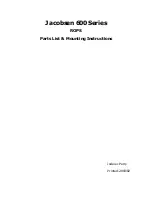
4-4 TROUBLESHOOTING
As an aid in localizing trouble, common symptoms together with their possible causes and reme
dies have been listed in groups corresponding to the major sections of the instrument. Of cours.e,
all possible troubles could not be included in the chart and the make-up of the chart has been based
on the assumption that the instrument has worked properly at some previous time. Keep in mind that
in trouble-shooting, the main endeavor is to find and eliminate the source of the trouble. Recurrence
of a trouble usually indicates that the effect, not the cause has been remedied.
4-5 TUBE REPLACEMENT
Tube location is shown in Fig. 7. When the CRT is replaced, it must be rotated until the hori
zontal trace is level.
4- 6 FUSE REPLACEMENT
A 1 Amp fuse is located in the fuseholder on the rear chassis apron. If the fuse should blow, the
component that has failed and caused the excessive current drain must be found and replaced before
a new fuse is inserted.
4-7. TROUBLESHOOTING CHART
SYMPTOM
Pilot light fails to light
Fuse, F1, blows when
AC power is turned on
Some or all filaments
fail to light
TROUBLE
POWER SUPPLY
INTENSITY switch in OFF position
No AC line voltage
Pilot lamp open
Fuse defective
Power transformer defective
Broken lead/or leads in the
filament path
Shorted AC line cable on the primary
side of the power transformer
Defective rectifier tubes
Defective filter capacitors
Short in filament connections
REMEDY
Turn INTENSITY switch clockwise
Trace line failure
Replace I1
Replace F1
Replace T1
Repair defective connections
Repair the short
Check V3, V6. Replace if bad.
Check C 13, C 10, C 11, for low
resistance or short. Replace if
necessary
Check filament connections for
shorts . Repair if necessary.
Defective tube or tubes
Replace tube or tubes *
Broken lead from power transformer Check with an ohmmeter for
continuity. Repair
if
necessary .
Power transformer defective
Replace
*Indicates replacement of component in this group makes it necessary to repeat some part of the
initial adjustment procedure.
32
















































